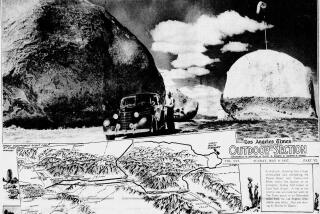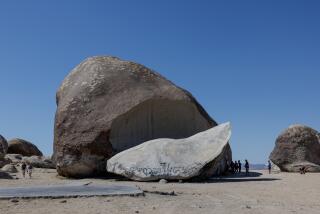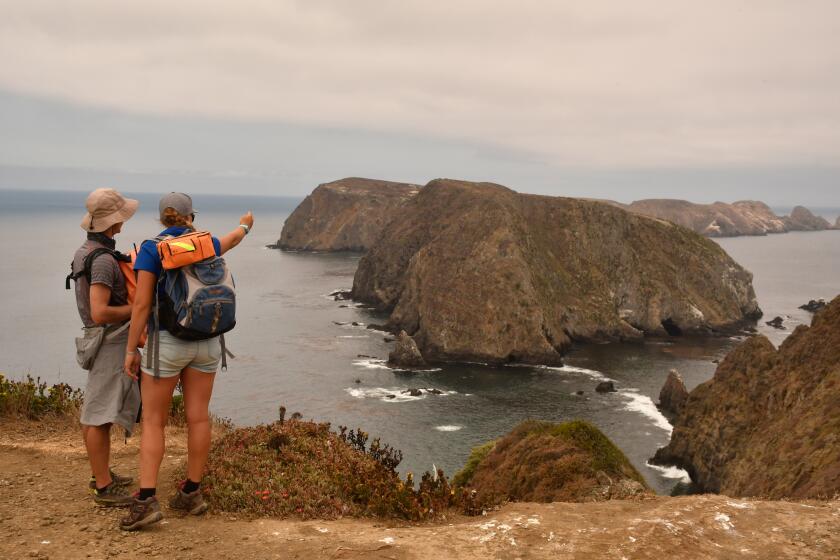He’s Still on the Rocks With a Geological Dilemma
- Share via
I have received several exciting suggestions for what I can do with our fossilized rock to enrich our own lives or the cultural life of the community.
You may remember that the rock was given to us by John Weaver and was left in trust for us with a mutual friend, John Beck, when Weaver moved to North Carolina.
It is a part of the tons of fossilized rock unearthed in 1969 from the excavation for Arco Plaza at 6th Street and Flower. In describing it, I gave it only two dimensions. It is far from square, but it is about 19 by 9 by 9 inches, and its rough surface is completely covered with the glitter of fossilized sea animals.
According to Manley Natland, former Atlantic Richfield geologist, it is 5 million to 7 million years old, and was probably formed when an earthquake dislodged a great mass of sludge from the Los Feliz area (then the seashore) and moved it to the Arco site, where it solidified.
According to a Times article by Lynn Simross, the rock is about as hard as quartz (more than twice as hard as marble). It contains about 350 species of mollusks, snails and other animals. By city resolution, it is the official gemstone of Los Angeles.
So, my rock not only has obvious historical and geological value, it may also have some monetary value. Natland and his son, James, formed a company to convert the rock into cocktail tables, bar tops, bookends and various objets d’art. A cocktail table presented to Mayor Bradley was appraised, according to Simross, at $37,000 and one presented to President Reagan at $41,000.
Now called Natlandite, for the geologist who rescued and commercialized it, the rock is on exhibit in many famous museums and galleries, including the Los Angeles Natural History Museum.
“So keep your rock,” advises Gloria Cuadra, whose family owns two large polished pieces and an uncut stone that they acquired from the Natlands. She suggests that we might send our rock to Italy to have it cut and polished. The Natlands found that local stonecutters broke their saws on the Natlandite, so they sent it to a marble cutting company in Querceta, Italy, in the neighborhood where Michelangelo carved his David.
I have no desire to make money on this rock, which after all was a gift from a friend; however, I think it deserves some better fate that sitting on the floor of our garage.
I am beseeched by two schoolteachers to give or lend the rock to them for the edification of their students. Certainly there is merit in both appeals. But the resolution of this dilemma seems to require Solomonic judgment.
Joanne H. Gram writes: “I am the science and computer lab teacher for 720 elementary school students at Thomas Jefferson Elementary School in Pasadena. And a total rock nut. Last year I was the school’s first computer lab teacher and we had another science teacher two days a week. Now we can no longer afford the latter.
“When kids come into our computer lab they always look at my sea shell collections and my rock collections and learn to appreciate natural history. . . . So would you consider lending me your special rock? Seven-hundred twenty students would get a lot of scientific pleasure out of it and would write illustrated science reports about it in our computer lab. . . .”
I’m sure Mrs. Gram’s classroom would be a better repository for our rock than our garage. But what about this?
Darwin Horn, a teacher at Del Amo Elementary School, writes that he is also a rock nut. “I know what an awesome responsibility you have undertaken by accepting custody of this specimen and am prepared to offer you an honorable solution to this burden. I will add it to my teaching collection.
“As an esteemed member of this select collection, your rock will sit in fifth-grade class where it will be free to associate with its own kind. More importantly, though, it will serve to stimulate generations of kids to think about the Earth and the processes that have shaped it.
“One of my missions--to expose the children to nature--is important because most of them are city kids who have virtually no experience outside the confines of the urban setting. As we currently lack funds for extensive field trips, it is necessary to bring nature into the classroom. Hence my collection of rocks, sticks, plants, artifacts, bones and fossils. . . .”
When two harlots claimed to be the mother of the same child, Solomon determined which was the mother by watching the reaction of each when he proposed cutting the child in two. But if I cut the rock in two, the halves will be equally valid as scientific exhibits, and both appellants will be served.
Will some stonecutter come forward and risk his blades to help me solve this dilemma?
It is all the more important since I am informed by Dorothy Natland that her husband, the father of our rock, has had Alzheimer’s for 10 years and is in a nursing home.
More to Read
Sign up for Essential California
The most important California stories and recommendations in your inbox every morning.
You may occasionally receive promotional content from the Los Angeles Times.













